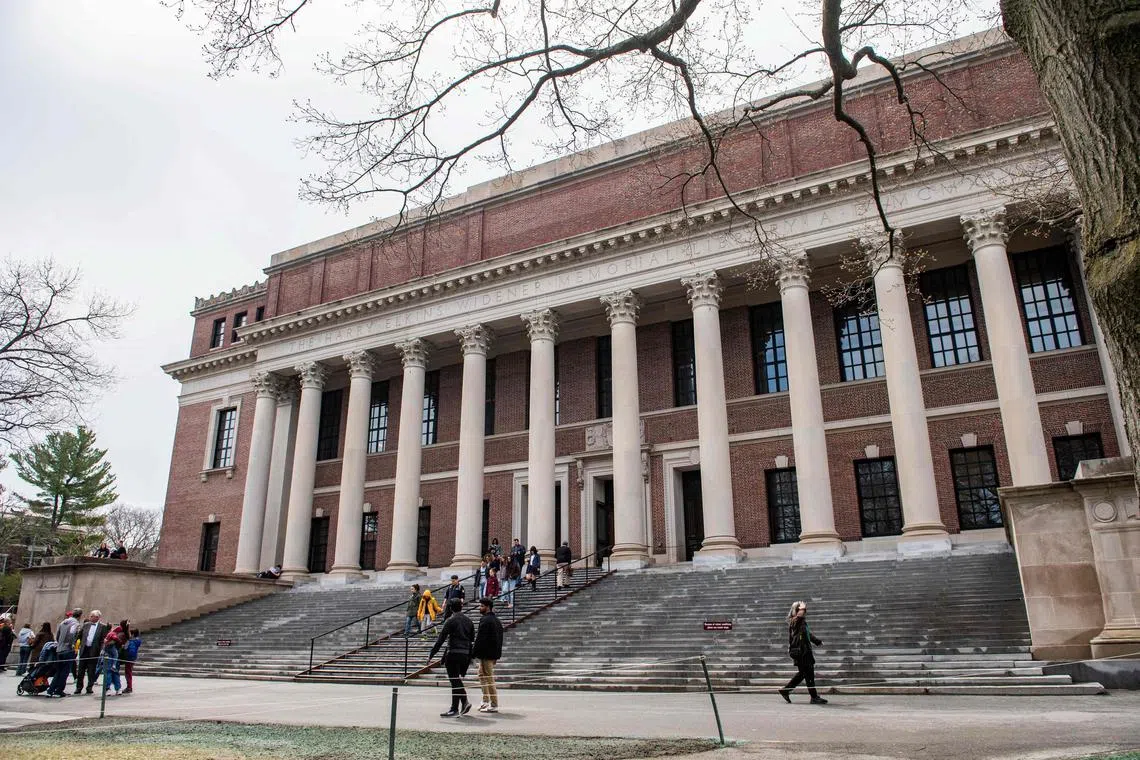Can Harvard’s billions withstand Trump’s federal funding fight?
Sign up now: Get ST's newsletters delivered to your inbox

The US’ wealthiest college has long hoarded cash and built its budget to withstand “shocks” as the Ivy League school put it in its financial statement.
PHOTO: AFP
Follow topic:
Harvard University’s balance sheet – fortified to withstand surprise blows – is facing an unprecedented test as it faces off with the Trump administration.
The United States’ wealthiest college has long hoarded cash and built its budget to withstand “shocks” as the Ivy League school put it in its financial statement.
It is armed with pristine credit ratings and a US$53 billion (S$69.9 billion) endowment – the most of any school.
That affluence makes it well situated to weather the strongest blow yet when a task force under President Donald Trump announced it would freeze US$2.2 billion in federal mone
The demands – prompted by widespread pro-Palestinian student protests on US campuses in 2024, which the administration has deemed anti-Semitic – included reforming the university’s governance; ending diversity, equity and inclusion programmes; changes to its admissions and hiring; and curbing the “power” of certain students, faculty and administrators because of their ideological views.
In his response to the demands, Harvard University president Alan Garber declared that the school would not “surrender its independence or constitutional rights”, which then triggered the US$2.2 billion freeze.
President Trump on April 15 then threatened Harvard’s tax-exempt status, yet another painful financial risk to the school.
“If there’s ever been an emergency, this is an emergency,” said Dr Sandy Baum, a higher education expert and non-resident senior fellow at the Urban Institute. “They could certainly take more money from their endowment, at least temporarily. But that doesn’t mean they could fund the huge amount of research – and replace the large amount of money they’re getting from the federal government.”
Harvard raked in US$6.5 billion of annual revenue in fiscal 2024 and enjoyed a US$45 million surplus.
Its financial resources “built over years through disciplined planning and sound financial management” are meant to “allow Harvard’s schools and units to withstand shocks”, the school said in its most recent financial report.
Former Goldman Sachs Group higher-education banker Ritu Kalra serves as Harvard’s chief financial officer.
Mr Timothy R. Barakett, who founded TRB Advisors, a private investment firm and family office, is its treasurer.
Though the school is cushioned by its endowment, over 80 per cent of the funds are restricted to certain purposes like financial aid, professorships and scholarships.
Most of the federal funding is tied to academic and scientific research.
Ever since World War II, the federal government has largely outsourced research projects to universities and today foots more than half the bill.
At Harvard, federal dollars make up 11 per cent of revenue and support research on Aids, cancer and organ transplants.
The endowment has helped Harvard hang onto its AAA credit rating, said Ms Abigail Urtz, a strategist for FHN Financial.
Elite colleges have options, from cutting back on spending and research programmes to selling debt for short-term funding, she said.
Schools are already “looking to alternative measures to offset the funding cuts or to protect them on a short-term basis”, she said. “If this were to happen over the longer term, it starts to get much more interesting and potentially problematic.”
Several colleges have recently sold taxable bonds, with Harvard doing so last week with a US$750 million offering.
The taxable market is easy for large colleges to access, and they have more flexibility on how to use the proceeds.
Post-2008 ‘retrench’
After the 2008 financial crisis, Harvard had to “retrench” and build up its resources after facing investment losses, according to old financial reports.
The endowment fell 27 per cent in fiscal 2009 and the value of the fund fell by US$11 billion.
The school then reduced payouts from the fund to pay for operations in the two following years.
Its endowment troubles were felt across campus, with the school suspending work on a science centre and Harvard Law restructuring a free tuition programme for students going into public service.
After that, the school looked to become more sophisticated in the way it handled its finances, its financial reports say.
And over 15 years later, Harvard has plenty of resources it can lean on.
Cash and investments total US$61 billion, which covers operating costs by approximately 10 times, Moody’s Ratings said.
Harvard can tap US$1.5 billion from banks as part of a revolving credit facility that it has not drawn upon yet, as at the end of the last fiscal year.
The school also has US$3 billion of capacity for commercial paper, a type of short-term funding commonly used for construction projects, according to its financial report for the 2024 fiscal year.
Using commercial paper for these projects offers a way to preserve cash.
“Harvard has taken steps to marshal its considerable financial resources to weather funding lapses,” said University of California sociology professor Charlie Eaton, author of Bankers In The Ivory Tower, a book about finance in higher education.
“The question is, how long can they continue their mission and hold out while the Trump administration uses all sorts of extralegal and potentially unlawful means to undermine its funding,” he said. BLOOMBERG

